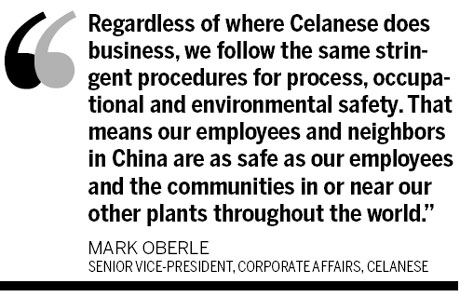-
News >Bizchina
Celanese shows blue sky thinking
2010-06-28 11:22Environmental care

Mark Oberle At present the largest single investment of Celanese in China is an integrated chemical facility in Nanjing, Jiangsu province, which is used to produce acetic acid and other chemical products.
The complex, which began operations in 2007, has used some of the company's most advanced technologies. As a result, it can save more energy and make less pollution compared with conventional facilities, said Oberle.
For instance, compared with the company's Pampa plant in the US, the Nanjing site has more than five times lower greenhouse gas emissions and releases 12 times less lower volatile organic compounds, in addition to using over ten times less energy to produce the same amount of product.
Celanese now has a global, cross-functional team to seek new process improvements, technologies and other enhancements that will significantly reduce energy consumption and greenhouse gas emissions. The team also encourages input from Celanese workers worldwide, challenging them to analyze and suggest improvements, said Oberle.
"We are on a journey to fulfill our promise to use less energy, cut waste, and reduce air emissions and water use," he said.
The company's efforts in environmental protection are also in line with the development of China's chemical industry, added Oberle. According to CPCIA, energy saving and environmental protection will be two focuses of China's petrochemical industry in the 12th five-year (2011-2015) period.
In terms of product structure, production of all petrochemical products should be more environmentally friendly. Some high-end chemical products such as engineering plastics should rely less on imports, according to CPCIA.International chemicals giants, which have advanced technologies, can play increasingly important roles in upgrading China's chemical industry, said Li Yongwu, head of CPCIA. Forty percent of Celanese's economic activities are now in the Asia-Pacific region, and 20 percent are in China, said Oberle.
It will certainly see some increase in these figures over the next few years, he added.
In 2007, Celanese relocated the strategic management of its acetyl business to Shanghai to manage its global business functions as well as to bear overall responsibility for Asia.

